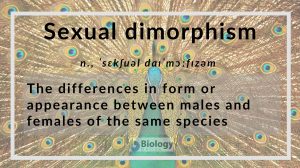
Sexual dimorphism
n., ˈsɛkʃuəl daɪˈmɔːfɪzəm
The differences in form or appearance between males and females of the same species aside from the differences in sexual organs
Table of Contents
Sexual Dimorphism Definition
Sexual dimorphism refers to the morphological differences (in form or appearance) between males and females of the same species aside from the differences in sexual organs. This means that the males are recognizable from the females of the same species. Hence, sex can be readily identified based on morphological features. The distinction can be based on the differences in size, shape, or color, for example.
Info
The word “dimorphism” is from Ancient Greek δίς (dís), meaning “twice” and Ancient Greek μορφή (morphḗ), meaning “form” or “shape”. The term “sexual dimorphism”, therefore, means two sexually distinct forms. The males show features that make them recognizable from the females of the same species.
The opposite holds true for sexual monomorphism. In sexual monomorphism (“mono”, meaning one), the males and the females of the same species look the same and therefore they cannot be sexually distinguished other than their genitalia.
Sexual dimorphism in a species occurs when differences in secondary sex characteristics are present. (Ref. 1) These secondary sex differences include differences in size, shape, weight, and color patterns or markings. Behavioral and cognitive differences between males and females may also be present. (Ref. 2)
Examples of Sexual Dimorphism
Many organisms show sexual dimorphism. A common example involves differences in the coloration and ornamentation. For instance, in peafowl, the plumage of a peacock is more colorful and elaborate than that of a peahen. The peahen has subdued plumage whereas the peacock has an ornate plumage. The peacock uses its plumage for attracting peahen. Another is the color distinction in the plumage of mallards. The male mallard has a bright green plumage on its head whereas the female mallard has light plumage. In some animal species, the distinction is more evident whereas in others the differences are subtle.
In humans and many other mammals, the males are larger than their female counterparts. In humans, though, the level of sexual dimorphism is relatively low compared with the other species. For instance, in the US, the mean mass of an adult male is around 78.5 kg whereas the mean mass of an adult female is about 62 kg. However, the standard deviation of male body mass is 12.6 kg, indicating that on average the adult males may even be lighter than the females. (Ref. 1)
As for the differences in behavior, an example is the elaborate song production by many male bird species. Males produce more complex songs than their female counterparts. Other examples include courtship behavior, nesting behavior, and foraging for food. (Ref. 3)
References
- Sexual Dimorphism. (2020). Nau.Edu. https://www2.nau.edu/~gaud/bio300b/sexdi.htm
- Sexual Dimorphism and sexual selection: Monkeys, Apes and Humans-Anth 1500. (2020). Missouri.Edu. http://web.missouri.edu/~flinnm/courses/mah/lectures/sexdim.htm
- Purves, D., Augustine, G. J., Fitzpatrick, D., Katz, L. C., Anthony-Samuel LaMantia, McNamara, J. O., & S Mark Williams. (2013). Sexually Dimorphic Behavior. Nih.Gov; Sinauer Associates. https://www.ncbi.nlm.nih.gov/books/NBK10975/
©BiologyOnline. Content provided and moderated by BiologyOnline Editors.







